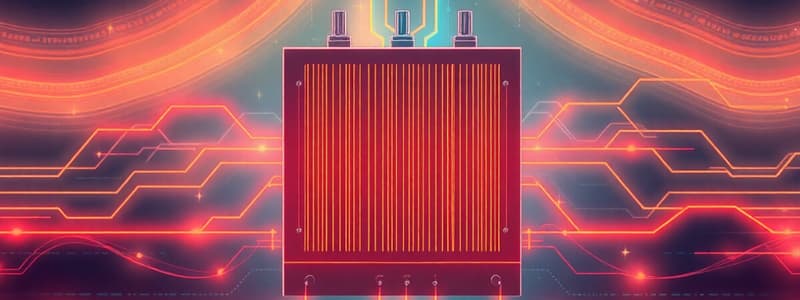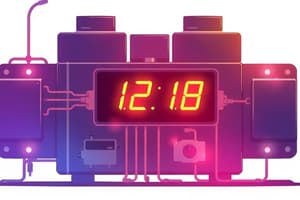Podcast
Questions and Answers
What characteristic of a junction diode allows it to be used in a rectifier circuit?
What characteristic of a junction diode allows it to be used in a rectifier circuit?
- It allows current to pass only when it is reverse biased.
- It allows current to pass equally in both directions.
- It blocks current flow regardless of bias.
- It allows current to pass only when it is forward biased. (correct)
A half-wave rectifier allows current to flow during both the positive and negative half-cycles of the AC input.
A half-wave rectifier allows current to flow during both the positive and negative half-cycles of the AC input.
False (B)
What type of transformer is typically used in a full-wave rectifier circuit to provide a center tapping?
What type of transformer is typically used in a full-wave rectifier circuit to provide a center tapping?
center-tap transformer
The output voltage of a rectifier, though still varying, is restricted to only one _________.
The output voltage of a rectifier, though still varying, is restricted to only one _________.
Match the rectifier type with its characteristic output:
Match the rectifier type with its characteristic output:
What happens to the diode in a half-wave rectifier when the voltage at point A is negative?
What happens to the diode in a half-wave rectifier when the voltage at point A is negative?
The reverse saturation current of a diode is significant and must always be accounted for in rectifier circuit calculations.
The reverse saturation current of a diode is significant and must always be accounted for in rectifier circuit calculations.
What is the purpose of ensuring that the reverse breakdown voltage of the diode is sufficiently higher than the peak AC voltage at the secondary of the transformer?
What is the purpose of ensuring that the reverse breakdown voltage of the diode is sufficiently higher than the peak AC voltage at the secondary of the transformer?
A circuit that uses a diode to convert alternating voltage to pulsating direct voltage is called a _________.
A circuit that uses a diode to convert alternating voltage to pulsating direct voltage is called a _________.
Match the following terms with their definitions:
Match the following terms with their definitions:
In a full-wave rectifier using two diodes, where is the output voltage taken?
In a full-wave rectifier using two diodes, where is the output voltage taken?
A full-wave rectifier always requires a center-tap transformer.
A full-wave rectifier always requires a center-tap transformer.
In a center-tap full-wave rectifier, what portion of the total secondary voltage is rectified by each diode?
In a center-tap full-wave rectifier, what portion of the total secondary voltage is rectified by each diode?
The process of converting alternating voltages into voltages that are restricted to one direction is called _________.
The process of converting alternating voltages into voltages that are restricted to one direction is called _________.
Match the description to the correct term:
Match the description to the correct term:
What is the main advantage of a full-wave rectifier over a half-wave rectifier?
What is the main advantage of a full-wave rectifier over a half-wave rectifier?
A rectifier is designed to amplify AC voltage.
A rectifier is designed to amplify AC voltage.
What type of voltage will appear across the load in a half-wave rectifier circuit?
What type of voltage will appear across the load in a half-wave rectifier circuit?
In the positive half-cycle of AC voltage, a diode in a rectifier circuit is _______ biased.
In the positive half-cycle of AC voltage, a diode in a rectifier circuit is _______ biased.
Match the biasing condition of the diode to the half-cycle of the AC voltage:
Match the biasing condition of the diode to the half-cycle of the AC voltage:
Flashcards
What is a Rectifier?
What is a Rectifier?
A circuit that rectifies alternating voltages, converting AC to pulsating DC.
What is a Half-Wave Rectifier?
What is a Half-Wave Rectifier?
A rectifier circuit that allows only one half-cycle of the AC input to pass through, blocking the other half.
What does it mean for a voltage to be rectified?
What does it mean for a voltage to be rectified?
Output voltage which is restricted to only one direction.
What is a Centre-Tap Transformer?
What is a Centre-Tap Transformer?
Signup and view all the flashcards
What is a Full-Wave Rectifier?
What is a Full-Wave Rectifier?
Signup and view all the flashcards
Study Notes
Application of Junction Diode as a Rectifier
- A junction diode allows current to pass only when it is forward biased.
- The property of a diode to allow current when forward biased is used to rectify alternating voltages.
- A circuit designed to rectify alternating voltages is called a rectifier.
Half-wave Rectifier
- With an alternating voltage applied across a diode in series with a load, a pulsating voltage appears across the load during the half cycles of AC input where the diode is forward biased.
- A rectifier circuit like this is called a half-wave rectifier.
- The secondary of a transformer supplies the desired AC voltage across terminals A and B.
- When the voltage at A is positive, the diode is forward biased, and it conducts.
- When A is negative, the diode is reverse-biased, and it does not conduct.
- The reverse saturation current of a diode is negligible and can be considered zero for practical purposes.
- The reverse breakdown voltage of the diode must be sufficiently higher than the peak AC voltage to protect the diode from reverse breakdown.
- In the positive half-cycle of AC, current flows through the load resistor R_L, producing an output voltage.
- There is no current in the negative half-cycle.
- In the next positive half-cycle, the output voltage is present again.
- The output voltage, although varying, is restricted to one direction and is rectified.
- The rectified output is present only for half of the input AC wave, hence the name half-wave rectifier.
Full-wave Rectifier
- A circuit using two diodes gives output rectified voltage corresponding to both the positive and negative halves of the AC cycle, and this is known as a full-wave rectifier.
- The P-sides of the two diodes connect to the ends of the secondary of the transformer, while the N-sides are connected together.
- Output is taken between the common point of the diodes and the midpoint of the transformer's secondary.
- A center tapping is provided for a full-wave rectifier, which is called a center-tap transformer.
- The voltage rectified by each diode is half the total secondary voltage.
- Each diode rectifies for half the cycle, but the two do so for alternate cycles.
- Output between common terminals and the transformer's center tap results in a full-wave rectifier output.
- There is another full-wave rectifier circuit that does not need a center-tap transformer but needs four diodes.
Studying That Suits You
Use AI to generate personalized quizzes and flashcards to suit your learning preferences.




